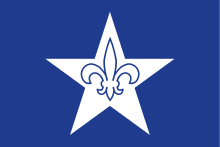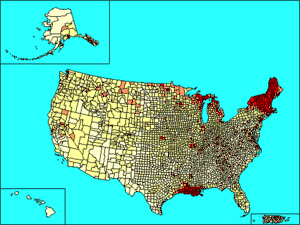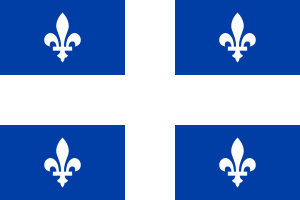History of the Franco-Americans
The Franco-Americans are a group of people of French, French-Canadian, and Acadian descent living in the United States. Today there are 11.8 million Franco-Americans in the US and 1.6 million Franco-Americans who speak French at home. There are also an additional 450,000 Americans who speak a French-based creole language, for example, Haitian Creole. Even though Franco-Americans are a substantial portion of the US population, they are generally less visible than other sizable ethnic groups. This is partly because of geographical dispersal (there are many regionally unique Franco-American groups, e.g. Louisiana Creole), and partly because a large proportion of Franco-Americans have acculturated or assimilated.
- Not to be confused with the Franco-Ontarian ethnic group.


Early Franco-American settlers

- The Franco-Americans were never part of the Franco-American alliance, an alliance made between Louis XVI and the United States during the American Revolutionary War .
Original settlers
Most Modern-day Franco-Americans of French Canadian or French heritage are the descendants of settlers who lived in Canada during the 17th century (Canada was known as New France at that time), Canada then came to be known as Province of Québec in 1763, which then renamed to Lower Canada in 1791, and then to the Canadian Province of Québec after the Canadian Confederation was formed in 1867. The majority of Franco-Americans of French Canadian origin, mostly the ones living in New England and the Mid-West, are those whose origins trace back to that of the Quebec Diaspora, also, not that many Franco-Americans are of Acadian descent, who came to the US from the Canadian Maritime regions. What is unusual about the early Franco-Americans is that they arrived before the formation of the United States. In the time before the American Revolutionary War, they founded many villages and cities and were some of the first Europeans to settle down in the US. Places that were main settlements for Franco-American settlers include the Midwest and Louisiana. Franco-Americans today are found mostly in New England and in the northern sections of New York, the Midwest and Louisiana. There are three main types of French-American; French Canadian, Cajun, or Louisiana Creole .[1]
Louisiana
During the period of French colonization in the Americas (1534-1763), France divided up all of its land into five territories; Canada, Acadia, Hudson Bay, Newfoundland and Louisiana. The Treaty of Utrecht seized France's control over Acadia, Newfoundland and Hudson Bay. After this treaty the colony of Cape Breton Island was established as the successor to Acadia.[2]
By 1679, La Louisiane française or French Louisiana was an administrative district of New France. Under French control from 1682–1762 and 1802–04, the area was named after Louis XIV, by French explorer René-Robert Cavelier, Sieur de la Salle. It initially covered a vast territory that included most of the drainage basin of the Mississippi River and stretched from the Great Lakes to the Gulf of Mexico and from the Appalachian Mountains to the Rocky Mountains. Louisiana was split up into two regions, known as Upper Louisiana, Upper Louisiana's land began north of the Arkansas River, and Lower Louisiana. The modern U.S. state of Louisiana is after the historical region, although it occupies only a small portion of what it originally was meant to have.
French pioneers explored the area began during the reign of King Louis XIV, while French Louisiana was not greatly developed, due to the deficiency of human and financial resources. As the result of France's defeat in the Seven Years' War, France was forced, in 1763, to relinquish the eastern part of the territory to the victorious British, and the western regions to Spain as compensation for Spain's loss of Florida. Direct French colonization ended with this transfer of authority, but Louisiana nevertheless remained a refuge for forcibly displaced Acadians, who were dispersed across the Thirteen Colonies. This population became what we know as the Cajuns.[3]
France regained sovereignty of the western territory in the secret Treaty of San Ildefonso of 1800. But, strained by obligations in Europe, Napoleon Bonaparte decided to sell the territory to the United States in the Louisiana Purchase of 1803, ending France's presence in Louisiana.
North American Franco-American colonies
In 1562 French naval officer Jean Ribault sailed with his fleet to the New World to found Fort Caroline, which is now Jacksonville, Florida. Fort Caroline was a haven for Huguenot culture (French Protestant). The Spanish, seeing the danger of these Protestant colonists killed Ribault and many of his followers in 1565. Stopped by the French government from establishing colonies in New France, a group of Huguenots, led by Jessé de Forest, sailed to North America and settled in the Dutch colony of New Netherland (later part of New York and New Jersey), as well as several British colonies including Nova Scotia. A number of New Amsterdam's main families were of Huguenot origin. In 1628 the Huguenots established a church congregation called L'Église française à la Nouvelle-Amsterdam.
Having arrived in New Amsterdam, Huguenots were granted land directly across from the Manhattan settlers on Long Island for a permanent settlement and they also settled near the harbor Newtown Creek, they were the first Europeans to live in Brooklyn, then known as Boschwick, and today the neighborhood known as Bushwick.
Later Franco-Americans
Causes of the Quebec diaspora
The Loyalist diaspora was the main cause for the Quebec diaspora. Following the defeat of Great Britain during the American Revolutionary War, colonists loyal to the British crown were punished. Many families were expelled and exiled from the newly created United States because they had been consistently loyal to Great Britain and they refused to swear allegiance to the United States and they also refused to give up now American lands. Some were also punished because they did not obey the new laws of the United States. Due to this, British Loyalists had to flee the US and take refuge in Canada. Canada now had to support 50,000 refugees. Over 32,000 Loyalists fled New York for Nova Scotia and an additional 13,000 took refuge in Quebec, Canada at the time had a population of just over 70,000, most being French-Canadian. The British, as they ruled Canada, valued their own countrymen more than the Francophone population, and they needed land for the refugees. As Nova Scotia took in most of the refugees, the sheer upkeep of most of the new arrivals would mean political tension in the colonies. The territory of New Scotia was divided in two and Loyalists were allowed full authority of their territory which was known as New Brunswick.
Meanwhile, in Quebec (which was known as just Canada during the second half of the 18th century) the authorities feared that riots and tension would occur if the Loyalists settled in French-Canadian communities.[4] Governor Haldimand thus relocated many newcomers to settle in the region of the Great Lakes, which was considered part of Quebec and thus under French law. The new arrivals did not like the legal system, so Canada was divided into two main regions; Upper Canada and Lower Canada, the other names for these regions were Ontario and Quebec. The British parliament approved of this division of Canada in 1791 and by 1792 it came into practice. In Quebec, Loyalists could petition for land as long as they demonstrated that they had suffered for their continuous loyalty to Britain in the United States. They also needed to gather a group of colonists together and get them to swear fealty to the British crown and they had to promise to develop the land they were granted. Once they were given land, they were expected to build roads, mills and to survey the neighboring settlements and overlook nearby and close regions at their own expense.
The only problems at first for these new settlers were the black flies and mosquitoes that infested the land granted to them by the British crown. Wolves were also a big problem for farmers. The first harvests were poor and were barely enough to meet local demand. The farmers had very little to sell to the public. Small villages set up would sometimes die out and settlers would have to emigrate to another settlement. The borders between Canada and the United States was not definite until 1842. Border conflicts between Canadian settlers and the US army were constant. Sometimes, American invasions would take place in 1838 during the Fenians Uprisals. By the middle 19th century some Loyalists began to emigrate out of Canada, seeking to colonize the Midwest of America.
The Quebec diaspora

The Quebec diaspora, often called "grande saignée" (the great demographic hemorrhage), was a period of mass immigration of inhabitants of Quebec dispersing across North America. The Canadian immigrants emigrated to New England and the American Midwest, Ontario, and the Canadian Prairies. This phase of migration started in 1840 and ended with the Great Depression in the 1930s. This chapter of Franco-American history has been surveyed and detailed by historians François Weil[5], Yves Roby[6], and Armand Chartier.[7]
Immigration to the United States
Due to a sudden growth in population, families could not support themselves due to law and systems, but also because the new British leaders of Canada reserved land for the English and English systems of colonization, not to mention there was also the "Château Clique" which ruled the Province of Quebec blocking expansion of housing and land development, French Canadians did not have enough room to live in. New England was industrializing, approximately 900,000 French-Canadians who lived in Quebec (some were of other French origins e.g. Acadian) left Quebec to go and find a job in the United States. Only around 50% of the migrants reported returning to Canada. The French-Canadians and other Frenchmen who stayed got together to form communities known as "Little Canadas". A vast number of Americans with French ancestry trace it back to Quebec. Other Franco-Americans, particularly the ones from the South, were originally from Acadia - the Cajuns - and there were a few from France directly. Up until the year 1849, the Catholic Church was not allowed to purchase any additional land, or found any parishes in the Eastern Townships due to English Protestant laws and control. By orders of Father Bernard O'Reilley, an Association des Townships was founded in 1848 to promote settlement in the area of Canada. In the 1850s, the association bought lands which were then given to young families of farmers to prevent them from leaving for the United States where it was believed they would ultimately be assimilated.
Many American textile manufactures and other industries opened up jobs for French-Canadian immigrants, such as ones in Lewiston and other bordering counties in Maine; Fall River, Holyoke and Lowell in Massachusetts; Woonsocket in Rhode Island; Manchester in New Hampshire and the bordering regions in Vermont. There were also many French-Canadian immigrants who moved to the Kankakee, IL area from the 1830s through the 1870s, including religious missionaries, establishing communities such as Bourbonnais, St. Anne, St. Georges, Papineau, and L'Erable. There are also vast populations of French-Canadian descent in Michigan and Minnesota — who began emigrating there when the region was still part of New France. The Museum of Work and Culture in Woonsocket, Rhode Island, explains and details New England's Quebec diaspora which developed in the 19th and early 20th centuries. Notable Americans of French-Canadian descent include writer Jack Kerouac, politician Mike Gravel, singers Rudy Vallée and Robert Goulet, Emil Beaulieau, historian Will Durant and many others.[8]
Newspapers
Due to the Quebec diaspora many French-Canadians left Quebec to go and live in the United States and other North-American countries and regions. These immigrants not only brought with them the French language, but religion and tradition. Many newspaper companies were founded and there are still some that exist today.[9]
Notes
- http://francoamericanarchives.org/about-nous-autres/franco-american-history/franco-american-americain/#sthash.oKYIDHuL.dpuf
- "Archived copy". Archived from the original on 2013-03-24. Retrieved 2013-11-18.CS1 maint: archived copy as title (link)
- Faragher, John Mack (2005). A Great and Noble Scheme: The Tragic Story of the Expulsion of the French Acadians from their American Homeland. New York City: W. W. Norton.
- http://provincequebec.com/history-of-quebec/loyalist-diaspora/
- Weil, François (1989). Les Franco-américains, 1860-1980. Paris: Belin.
- Roby, Yves (1990). Les Franco-Américains de la Nouvelle-Angleterre. Sillery: Septentrion.
- Chartier, Armand B. (1991). Histoire des Franco-américains de la Nouvelle-Angleterre, 1775-1930. Sillery: Septentrion.
- http://english.turkcebilgi.com/Quebec+diaspora
- Perreault, Robert B. (1984). "Survol de la presse franco-américaine". In Quintal, Claire (ed.). Quatrième Colloque de l’Institut français: Le journalisme de langue française aux Etats-Unis. Quebec City: Conseil de la vie française en Amérique. pp. 9–34.
External links
- Institut Franco-Américain, France
- Conseil Pour Le Development du Francais en Louisiane (CODOFIL)
- French Institute of Assumption College, Massachusetts
- Franco-American Institute of Salem, Massachusetts
- Franco-American Center, New Hampshire